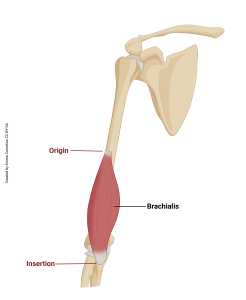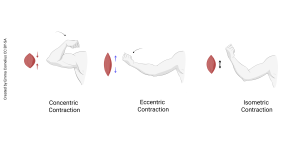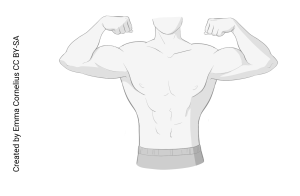Muscle Terminology and Contraction Types
Objective 10.8
10.8.1 Define and describe the terms origin, insertion, action, prime mover, agonist, antagonist, synergist, and fixator.
10.8.2 Define and compare the types of muscle contraction: concentric, eccentric, and isometric.
Muscles work together with the skeletal system to provide body movements. In most body movements, bones work together at a joint. The bones that form a joint are referred to as articulating, meaning they move with each other. Typically, one bone moves more than the other in response to muscle contractions. This fixed bone is referred to as the origin of the muscle and is usually the more proximal of the articulating bones. The bone that moves more during muscle contraction is where we would find the point of insertion for the muscle.
more than the other in response to muscle contractions. This fixed bone is referred to as the origin of the muscle and is usually the more proximal of the articulating bones. The bone that moves more during muscle contraction is where we would find the point of insertion for the muscle.
The shortening of sarcomeres during muscle contraction generates force. This force is known as muscle tension and is most commonly thought of when one considers moving an object, however muscle tension is also generated when muscles contract against an object that doesn’t move. Movement of an object through muscle contraction, like when one lifts weights, is known as isotonic (same tone or strength) contraction. Isotonic contraction can be divided into concentric contraction, which moves an object closer to the body, and eccentric contraction, which moves the object away from the body. The major difference is the way in which actin and myosin fibers overlap to shorten the sarcomeres (concentric) or release their connections to each other to allow the muscle to elongate (eccentric).
When muscles contract but the object doesn’t move, the contraction is referred to as isometric (same distance). Imagine trying to lift a weight that is too heavy. Sarcomeres shorten in an effort to produce enough force to move the object, however the object doesn’t move. Actin and myosin filaments can only overlap so much before the weight of the load exceeds their ability to continue to shorten the muscle. Simply maintaining a standing or sitting position are examples of isometric contractions.

Regardless of the movement of objects, when muscles contract, they can have a number of results, known as the action of the muscle. Flexion is a type of muscle movement that results in a decrease in the angle of the joint. For example, image a little kid who wants to show you how big their muscles are. When they “flex their muscles” they are most likely contracting their brachialis and biceps brachii muscle, pulling the radius and ulna towards the humerus, forming something close to a 90° angle. (The biceps gets all the credit, but the brachialis does most of the work. Stop me if you’ve heard this story before.)
Extension is like the opposite of flexion. The result of extension is an increase in the angle made at the joint. When the kid is done showing off their “big muscles,” they will likely contract their triceps muscles and relax the biceps. This will pull on the opposite side of the radius and ulna, returning the angle to the 180°.
Muscles rarely do any work in isolation. They often have other muscles to help them, or even oppose them. We will explore the terms we use to describe the relationship between muscles.
The prime mover of an action is called the agonist. The agonist is the muscle that does most of the work to complete an action, such as elbow flexion.
If a muscle does the opposite action, it is called an antagonist. If the agonist performs elbow flexion, the antagonist would perform elbow extension.
A synergist aids the agonist with creating the movement. If the agonist performs elbow flexion, the synergist helps with elbow flexion.
flexion.
A fixator stabilizes a joint to allow the agonist to complete its action.
Here is a recap of the above information with some muscles inserted for the actions. We will learn some of these muscles in an upcoming objective. For now, just focus on the relationship terms and understanding the concept.
To complete the task of elbow flexion, you have the following relationships:
- Agonist: brachialis
- Antagonist: triceps brachii
- Synergists: biceps brachii, brachioradialis
- Fixators: rotator cuff muscles (individual names later)
Media Attributions
- U10-033 origin and insertion © Cornelius, Emma is licensed under a CC BY-SA (Attribution ShareAlike) license
- U10-034 muscle contractions © Cornelius, Emma is licensed under a CC BY-SA (Attribution ShareAlike) license
- U10-035 flex © Cornelius, Emma is licensed under a CC BY-SA (Attribution ShareAlike) license

